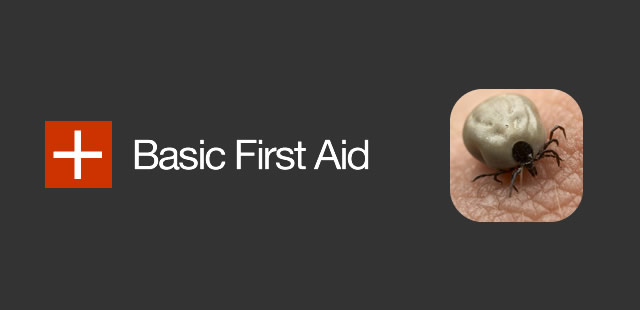
Contents
First aid – Tick bites
Introduction:
Ticks are small spider like animals (arachnids) that bite to fasten themselves onto the skin and feed on blood. Ticks live in the fur and feathers of many birds and animals. Tick bites occur most often during early spring to late summer and in areas where there are many wild animals and birds.
Most ticks don’t carry diseases, and most tick bites don’t cause serious health problems. But it is important to remove a tick as soon as you find it. Removing the tick’s body helps you avoid diseases the tick may pass on during feeding. Removing the tick’s head helps prevent an infection in the skin where it bit you. See Home Treatment for the best way to remove a tick.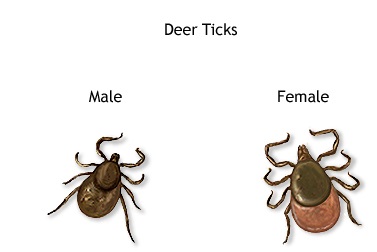
Usually, removing the tick, washing the site of the bite, and watching for signs of illness are all that is needed. When you have a tick bite, it is important to determine whether you need a tetanus shot to prevent tetanus (lock jaw).
Definition:
Ticks are small, insect-like creatures that can attach to you as you brush past bushes, plants, and grass. Once on you, ticks often move to a warm, moist location, like the armpits, groin, and hair. At that point, they typically attach firmly to your skin and begin to draw blood. Ticks are important as they can transmit bacteria that cause illness.
Ticks can be fairly large — about the size of a pencil eraser — or so small that they are almost impossible to see. There are approximately 850 different types of ticks. Ticks can cause a variety of health conditions ranging from harmless to serious.
Alternative Names
Poisonous Ingredient
Hard- and soft-bodied female ticks are believed to make a poison that can cause tick paralysis in children.
Some people may have an allergic reaction to a tick bite. This reaction may be mild, with a few annoying symptoms. In rare cases, a severe allergic reaction (anaphylaxis) may occur.
Many of the diseases ticks carry cause flu-like symptoms, such as fever, headache, nausea, vomiting, and muscle aches. Symptoms may begin from 1 day to 3 weeks after the tick bite. Sometimes a rash or sore appears along with the flu-like symptoms.
Common tick-borne diseases include:
- Lyme disease.
- Rocky Mountain spotted fever.
- Tularemia.
- Ehrlichiosis.
- Relapsing fever.
- Colorado tick fever.
- Babesiosis.
Tick paralysis is a rare problem that may occur after a tick bite. In some parts of the world, tick bites may cause other tick-borne diseases, such as South African tick-bite fever.
Symptoms:
Watch for the symptoms of tick-borne diseases in the weeks following a tick bite — muscle or joint aches, stiff neck, headache, weakness, fever, swollen lymph nodes, and other flu-like symptoms. Watch for a red spot or rash starting at the location of the bite.
The symptoms below refer more to the problems resulting from the bite itself, not the diseases that a bite may cause. Some of the symptoms are specific to one variety of tick or another, but not necessarily common to all ticks.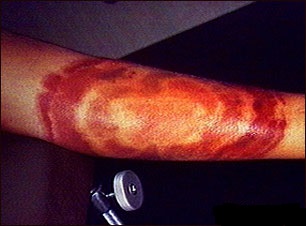
- Apnea (breathing stopped)
- Blisters
- Difficulty breathing
- Rash
- Severe pain at bite site (some varieties), lasting for several weeks
- Swelling at bite site (some varieties)
- Weakness
- Uncoordinated movement
First off there are three kinds of ticks you need to worry about:
Brown dog ticks: These are the most widespread ticks, as they can be found all over the world. Luckily these ticks prefer dogs to people, so humans are rarely bit by them. Unluckily if your pet has a large infestation of them, they risk suffering from anemia.
American dog ticks: These ticks are most abundant in eastern North America and usually bite humans, dogs, and wildlife. These ticks are known to carry the organism that causes Rocky Mountain Fever.
Lone star ticks: These ticks are found from TX to OK, eastward to the Atlantic coast, and from Mexico to Central and South America. These ticks are also known to pass along Rocky Mountain Fever.
Deer ticks: These are the guys to watch out for. Found all over America deer ticks are usually found on white tailed deer, and are then spread to humans who pass though an area frequented by deer. These ticks are much smaller than most other ticks (which are about the size of a pencil eraser), as they are only about the size of a sesame seed.
Watch for the symptoms of these diseases in the weeks following a tick bite:
- Fever
- Headache
- Muscle or joint aches
- Other flu-like symptoms
- Stiff neck
- Swollen lymph nodes
- Weakness
First Aid:
If a tick is attached to you, follow these steps to remove it:
- Grasp the tick close to its head or mouth with tweezers. Do not use your bare fingers. If needed, use a tissue or paper towel.
- Pull it straight out with a slow and steady motion. Avoid squeezing or crushing the tick. Be careful not to leave the head embedded in the skin.
- Clean the area thoroughly with soap and water. Also wash your hands thoroughly.
- Save the tick in a jar and watch carefully for the next week or two for signs of Lyme disease.
- If all parts of the tick cannot be removed, get medical help. Bring the tick in the jar to your doctor’s appointment.
Prevention:
Wear protective clothing whenever possible when traveling through terrain which is known to harbor ticks. Inspect your skin and clothing after being outdoors where ticks are known to be present, and remove them as discussed above. Also inspect any household pets which have been in tick-infested areas.
- Wear long pants and long sleeves when walking through heavy brush, tall grass, and densely wooded areas.
- Pull your socks over the outside of your pants to prevent ticks from crawling up inside.
- Keep your shirt tucked into your pants.
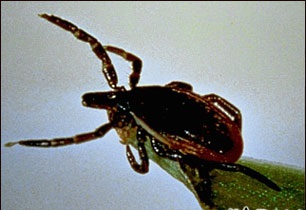
- Wear light-colored clothes so that ticks can be spotted easily.
- Spray your clothes with insect repellent.
- Check your clothes and skin frequently while in the woods.
After returning home:
- Remove your clothes and thoroughly inspect all skin surface areas, including your scalp. Ticks can quickly climb up the length of your body.
- Some ticks are large and easy to locate. Other ticks can be quite small, so carefully evaluate all black or brown spots on the skin.
- If possible ask someone to help you examine your body for ticks.
- An adult should examine children carefully.
Call immediately for emergency medical assistance if:
Call your doctor if you have not been able to remove the entire tick. Also call if in the days following a tick bite you develop:
- A rash
- Flu-like symptoms
- Joint pain or redness
- Swollen lymph nodes
Call emergency if you have any signs of:
- Chest pain
- Heart palpitations
- Paralysis
- Severe headache
- Trouble breathing
How you avoid getting bit by a tick:
- Tuck your pant legs into your socks or shoes and tuck your shirt into your pants. Because ticks usually climb from the ground up, this will keep them on the outside of your clothes where it will be easier to find them.
- Wear light colored clothing. It will be easier to spot any ticks that grab on to you.
- Put the buddy system to good use. You and your companions should inspect each other often for ticks when you are in their habitat, and do a thorough search when you return home.
- Since ticks like to attach themselves to the head and neck, be sure you check that area out completely.
- If you work in an area where ticks are commonly found, then avoid wearing your work clothing home, as any attached ticks could then be brought into your home.
- Also, check any pets that go outside and frolic in grassy, brushy, or wooded areas as ticks may be transferred from them to you.
- And lastly wear insect repellents. DEET repellents (DEET no more than 30%) can be applied to the skin, and a stronger Permeation tick repellent and pesticide (not allowed in some states) may be applied directly to clothing (shoes, socks, cuffs and pant legs are most effective), tents and other gear or apparel. This pesticide should last about two weeks and two laundering.
I got bit anyway, how do I remove the tick?
- Ticks should be removed as soon as possible to avoid contracting the diseases many of them carry.
- Using a pair of tweezers, get as close to your skin and its head as you can and slowly and gently pull the tick out.
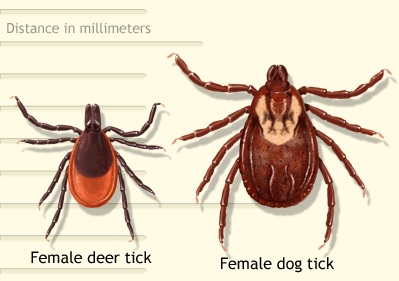
- If you grab and squeeze to hard then the head and mouth parts may break off and remain in your skin. If this happens then seek medical help to have them removed.
- Once the tick has been removed, you may want to save it in a small jar to have it tested and identified. (if you chose to do this put an alcohol soaked cotton swab in with the tick for preservation purposes)
- After this then you should wash the bite area with soap and water and apply an antiseptic ointment.
Do Not
- Do NOT try to burn the tick with a match or other hot object.
- Do NOT twist the tick when pulling it out.
- Do NOT try to kill, smother, or lubricate the tick with oil, alcohol, vaseline, or similar material.
First aid video for remove a tick-1
First aid video for remove a tick-2
